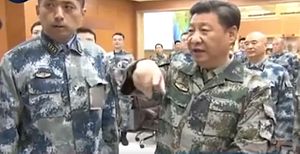In a move to further consolidate his control over China’s military, Chinese President Xi Jinping added a new title to his growing list of titles: commander-in-chief. The Chinese People’s Liberation Army has seen its most wide-ranging organizational changes since the 1950s over the last six months. The reforms, which restructure the PLA’s four general departments among other changes, bring the PLA—the world’s largest military by personnel size—squarely under Xi’s command.
Wednesday’s events involved an added element of propaganda and theatrics that served to drive home that fact that Xi was more than a suited-and-coiffed general-secretary and president. To seal in his claim as the commander-in-chief of the PLA, Xi donned military fatigues and inspected the powerful Central Military Commission’s (CMC) joint battle command center. According to Xinhua, Xi called for a “joint battle command system with Chinese characteristics.” Part of the ongoing reform of the PLA seeks to better position the Chinese armed forces to operate as a coordinated force, with an increased focus on the maritime domain. In keeping with that theme, China’s most recent defense white paper saw the PLA embrace a more global and expeditionary vision.
Furthermore, echoing a theme in his approach to PLA reform, Xi emphasized loyalty, demanding a command structure that was “absolutely loyal, resourceful in fighting, efficient in commanding, and courageous and capable of winning wars,” according to Xinhua. Reforms to the PLA have coincided with an intensification of an anti-corruption campaign across China, focusing on civilian and military leaders alike. In recent years, several high-level PLA generals and even former vice chairmen of the Central Military Commission, such as Generals Guo Boxiong and Xu Caihou, have been prosecuted.
On Wednesday, Xi placed a particular emphasis on the PLA’s readiness for war. “The current situation requires battle command to be highly strategic, coordinated, timely, professional and accurate,” Xi said, adding that this “must be done with the ultimate goal of improving battle command capacities and measured by the standards of being able to fight and win wars.”
Xi’s continuing reform of the PLA comes at a time when China’s foreign policy is being perceived as increasingly assertive by its Asian neighbors and the United States alike. In the East and South China Seas, Chinese irredentism continues to stoke tensions. Recent reforms to the PLA will ensure that if China has to exercise its hard power and deploy military force to protect its interests, it’ll all be done under President—and commander-in-chief—Xi Jinping’s watch.

































